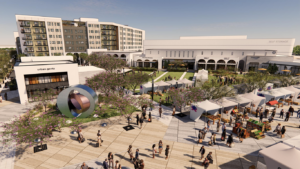As we close the page on 2021, hopes that we would be doing the same on COVID-19 have stalled. The Omicron variant has been shuttering businesses, canceling flights and clouding the near-term outlook. But ever since the emergence of COVID-19 in early 2020, one thing that the virus couldn’t stop was Arizona’s commercial growth. Brokers, developers and builders are reporting record numbers in 2021, exceeding 2020’s exceptional performance, which was one of the best years on record for the region. Net absorption, rental rates and sales volume are at historic highs, and vacancies have shrunk to an all-time low.
Leading the way are the industrial and multifamily markets.
“Industrial leasing in capital markets and multifamily capital markets have carried every large brokerage firm’s production in 2021,” says Mike Garlick, executive managing director for Newmark Knight Frank.
READ ALSO: Here are 35 commercial real estate projects to know
More than 24 million square feet of industrial construction is underway across Greater Phoenix, with approximately 30 million square feet completed in 2021. And more than 32,000 new multifamily units are under construction or were completed during the year.
While the brokers, developers and builders remain bullish on the Phoenix market heading into 2022, one of the top concerns is supply chain delays. Manufacturers are still not at full capacity and product delays could continue well into 2023.
“It’s difficult to look out to 2022 and 2023 and not consider the impact of supply chain issues, inflation and labor shortages,” says Walter Crutchfield, partner of Vintage Partners.
Anthony Johnson, industrial business unit president for Clayco, adds, “Material shortages are probably the biggest constraint in the market right now. There would be more under construction and being delivered if people could get the materials they need. Take roofing materials, for example. What we used to be able to get in a matter of weeks now has nine-month delivery times. There are many structures with no roofs on them because the materials aren’t available.”
So what does this all mean for the future? We talked to experts in the various market sectors to get their insight into what we can expect from the Phoenix commercial real estate outlook in 2022.
Outlook for industrial
“Phoenix has arrived on the stage in a national way where we can go toe-to-toe with any of the large, major markets,” says Will Strong, executive managing director for Cushman & Wakefield.
According into the brokerage firm’s Q3 2021 Industrial Marketbeat report, Phoenix ranks fifth in U.S. industrial markets for construction activity. Most of that development is speculative.
“Probably three-quarters of the work on our schedule is spec,” says Jeff Dalton, vice president of FCL Builders. “During the pandemic, tenants wanted something that was already built. They expected to come in and find a 700,000-square-foot, 800,000-square-foot, 1 million-square-foot building ready to go. It’s a big ask for a developer, but they’re meeting it.”
Johnson notes that this increase in spec development has placed Phoenix in the upper echelon of industrial markets in the country. “In short order, Phoenix has gone from a smaller tier market with smaller-sized buildings to a large tier market with a lot of buildings that are a million square feet or larger,” he explains.
The bulk of industrial development in 2021 occurred in the far east and west Valleys, where open land is plentiful and infrastructure attractive.
One significant spec development that broke ground in Q4 is CapRock West 202 Logistics, the largest spec project in the history of the City Phoenix. Occupying a 183-acre infill site at the northeast corner of North 59th Avenue and West Van Buren Street, the 3.4 million-square-foot complex will consist of five buildings ranging in size from 228,000 square feet to 1.065 million square feet and cost approximately $200 million. Completion is anticipated by year-end 2022.
Also on the lips of commercial real estate (CRE) experts since early 2021 is the arrival of Taiwan Semiconductor Manufacturing Company (TSMC) in North Phoenix. The $12 billion factory at the northwest corner of the Loop 303 and Interstate 17 is expected to bring 1,900 new jobs to the region — and is attracting even more development from companies wanting to locate close to it, which in return in increasing land prices.
“Deer Valley is probably the tightest submarket. Eighteen months ago, land was probably about $8 per square foot. Now deals are getting done at $24/$25 per square foot. A lot of that is because of TSMC,” says Jay Krew, senior vice president of ORION Investment Real Estate. “I’m dealing with a company that supplies nitrogen gas for the semiconductors. It has to be in an A-1-zoned property, but there’s such a scarcity of that in that area that it’s driving the prices up.”
Commercial real estate outlook for multifamily
According to the U.S. Census Bureau, Phoenix is projected to welcome 1.9 million new residents over the next 20 years —requiring almost 700,000 new single family and multifamily housing units.
“You’d think we’re overbuilding, but we’re not,” says Brad Cooke, executive vice president of multifamily investments for Colliers International. “We’re actually undersupplied with the amount of people who are moving here. That’s why average occupancies are at 97%,” besting the previous all-time occupancy high of 96.8% in the late 1970s.
According Colliers’ 2021 Q3 Phoenix MSA Multifamily Review, there are 32,367 units currently under construction throughout Greater Phoenix. “Your typical hot spots that were already in high demand — Tempe, Scottsdale, Chandler and Gilbert — continue to remain in high demand,” Cooke notes. Gilbert, in particular, is growing at a rate of 1.63% annually.
While development costs and rent prices remain economical compared with nationwide statistics, they continue to rise. “In the areas where we built, we’re averaging between $2.10 per square foot and $3 per square foot,” says Eric Jaeggars, residential business unit leader for Clayco. “We’ve even eclipsed the $3 mark in Downtown Phoenix. And it continues to increase. It’s hard to tell where the ceiling is.”
Rents have risen 22.4% to $1,531, according to the Colliers report. This growth rate is two times higher than the national average, which increased 10.7%, but it’s still $58 below the national average rent of $1,589.
In order to attract residents will to pay the rising rents, developers are adding more and more luxury amenities to projects. “Some of the projects that are under construction have some pretty incredible amenity spaces,” Jaeggars points out. “There are places to hang out for drinks, amazing workout areas with outdoor views, pool decks set up for parties.”
Strong rent growth will persist as demand continues to outstrip supply for the foreseeable future. “Apartment rents have got to hit a wall at some point,” says Krew. “Of course, I would have said that five years ago, and look at how wrong I would have been.”
According to Kidder Mathews‘ Q4 2021 Phoenix Multifamily Market Report, while double-digit growth is exceptions and cannot be sustained long-term, it is reasonable to expect annual rent growth to continues at rates above the national average for the next 18 to 24 months.
Outlook for office
Along with retail, office was one of the sectors hardest hit by COVID-19. The pandemic fundamentally changed the office environment, with many workers now demanding full-time work-from-home opportunities, but the number returning to the office is slowly increasing.
“The national average is still only 38% or 39% back in office,” Garlick notes.
While the office market ended Q3 2021 posting -317,887 square feet of net absorption, the second-lowest quarter since the beginning of the pandemic, that number was dramatically impacted by the JP Morgan Chase’s move out of downtown Phoenix.
Rental rates remained steady throughout the year, ending at $27.76 at the end of Q3, 1 cent below Q3 2020, according to Colliers 21Q3 Office report.
The third quarter delivered approximately 388,347 square feet of new office product across Greater Phoenix, driven by the completion of the UNION Building 1 in Mesa and Choice Hotels’ tech headquarters in Scottsdale. Construction remained strong, but activity is beginning to taper off as existing projects are completed.
“The price per square foot on building trades went up,” Garlick says. “Block 23 in Downtown Phoenix went for $488 per square foot. The esplanade at 24th Street and Camelback Road is going to trade for close to $400 per square foot. So there is capital coming into the market.
I think Phoenix is going to come out of COVID at a whole new mature market.”
Capex spending is project to increase and landlords look to entice workers back to the office. “Amenities are going to be off the chain,” Krew says. “Rest assured, office will come back, but it’s going to take a little time.”
Commercial real estate outlook for retail
Despite declarations that retail is dead, the sector is gaining momentum. Consumer spending increased 18.6% at the end of September compared with January 2020, a strong indicator that the sector is not just improving but instead thriving. According to Cushman & Wakefield’s Q3 2021 Retail Marketbeat report, vacancy in the Metro Phoenix retail market was 7.9%, down by 100 basis points from 8.9% in Q4 2020. The East Phoenix submarket recorded the lowest vacancy rate of 4.2%, while the North Central Phoenix and Mesa submarkets recorded the highest vacancy rates of 10.6% and 10%, respectively.
“The timeless truths are that people are moving here, and they want to gather and need services, so those things are going to drive the local retail real estate economy,” Crutchfield says.
Rommie Mojahed, director of retail leasing and sales investments with SVN|Desert Commercial Advisor, agrees. “Retail is extremely active right now,” he says. “Going out and shopping will never disappear, but the bar has been raised. You need to have a good product and a good location. You’re not seeing the kind of growth that happened pre-2008, when everyone was buying anything, but pads on good corners or in grocery-anchored settings are flying off the shelf.”
Walt Brown, founder and designated broker with Diversified Partners notes that A locations “have become priceless.” He points to hard corners, such as the intersections of Val Visa Drive and Queen Creek Road in Gilbert and Bell Road and 67th Avenue in Glendale as prime examples. “Tenants want locations that have traffic counts and can generate sales,” he says.
Rental rates continue to increase. According to Colliers 21Q3 Retail report, rents rose 2.4% year-over-year, ending at $14.94 per square foot. Ari Spiro, founding principal of ORION Investment Real Estate, notes that rents will most likely stabilize. “Most companies that signed on recently probably signed five-, six- or seven-year leases, so there’s not going to be as much movement,” he notes.
Mojahed predicts that ground leases will become more commonplace in 2022, while Crutchfield suggests that the Valley’s core — Central and Downtown Phoenix — will see more redevelopment. Restaurant concepts and retail innovations are outpacing the development of big box stores in established neighborhoods, while areas such as Queen Creek, San Tan Valley and even Apache Junction offer favorable opportunities for ground-up development.
Outlook for land
As Greater Phoenix continues to grow in population and business, the amount of land needed to support all the activity will also increase.
“The sheer number of people moving here — 100,000 a year in Maricopa and Pinal counties – requires a tremendous amount of land,” explains Greg Vogel, founder and CEO of Land Advisors Organization. “The typical consumption of land is 1 acre for every six people. So if you take that 100,000 and divide it by six, we need 16,000 to 17,000 acres of land each year for immediate development. If you look at how it’s going to be developed, I believe that 55% of the land demand will be in the West Valley with the balance being split by the Southeast Valley and Pinal County. It’s just a tremendous amount of land consumption.”
Recent years have seen an explosion of land deals. Buckeye, Glendale and Surprise are West Valley hot spots, while Mesa, Queen Creek and Pinal County are leading in the East.
“Over the past 12 months, there’s been $6 billion, approaching $7 billion, in land of all types that was traded throughout Maricopa and Pinal counties,” Vogel says. “To put that in context, it was $400 million in 2008, and it was running in the $2 billion range between 2015 and 2019.”
Because of the growing demand from developers, land is extremely scarce. “One of the biggest challenges going forward is finding land,” says Dalton. “The first-generation of land, the kind where you could talk to the farmer who was getting ready to sell, is gone. There isn’t any of that left in the Phoenix area or even near Casa Grande. You have to go down toward Maricopa or Marana.”
Jackob Andersen, president and CEO of Saint Holdings, notes, “There’s a misconception that there is land as far as the eye can see in Pinal County. Only a tiny piece of Pinal County is able to be owned. The rest is Indian and State land.”
Development in Pinal County and north of the Loop 303 in Phoenix is rapidly increasing due to an abundance of added infrastructure, while the development of State Route 30, which will parallel the I-10 and run through Avondale, Buckeye and Goodyear, looks to grow demand for land along the Gila River. In early December, 37,000 acres in Buckeye sold for $600 million for the development of a master-planned community. Eighty acres in Coolidge sold for nearly $27.5 million in August.
“There’s obviously been an uptick in development in the last two years, but as long as it carries on at a steady pace and is not just a land rush, that’s ideal for the market,” Andersen explains. “If we keep going forward and are sensible and don’t get greedy, we can all benefit.”
Commercial real estate outlook for healthcare
Phoenix is projected to add 1.9 million new residents in the next 20 years. In addition to housing, jobs and entertainment, healthcare is a major need for the growing population. The Valley’s major healthcare systems are expanding, opening hospitals and health clinics throughout the Valley. In May, Phoenix Children’s announced the development of a freestanding three-story hospital in Glendale; Dignity Health is opening the Mercy Gilbert Rehabilitation Hospital in Gilbert; and Abrazo Health recently completed a full-service micro-hospital in Cave Creek.
“As Phoenix grows, especially because we have sprawl, we’ll continue to see neighborhoods investing in their hospitals. And as long as the land is available, hospitals will continue to build in order to address the growing healthcare needs of the population as new communities start to develop,” says Trisha Talbot, founder of Doc Properties.
According to GlobeSt.com, the Phoenix medical office market has been a bright spot through the pandemic. It is one of the most active and sought-after in the country, and the momentum hasn’t slowed in the last year.
Marina Hammersmith, senior vice president at ORION Investment Real Estate, notes that the vacancy rate for medical in Chandler is less than 2%. “We have developers who would love to pull the trigger on projects in that area, but they can’t find the land opportunities to do so,” she says. “I think in order to meet the demand, we’re going to have to look at some creative repositioning of retail.”
Hammersmith continues, “Healthcare is going to remain a very strong segment. We’re going to continue to see absorption rate increases for any of those markets that have had some challenges. I’m probably biased, but healthcare is a fundamental need in the Valley. The trajectories for the sector look very strong. Adaptive reuse, where healthcare is inserted into retail and, to some extent, general office is going to continue. And investors are still going to want to deploy their capital in our state because it’s a strong economy. So I’m very bullish on healthcare.”
The forecast for Arizona calls for continued strong growth. The state is expected to generate job, income and population gains at a much faster pace than the nation, with Phoenix generating gains even faster than the state average.
“There are a lot of interesting dynamics happening in Phoenix,” Johnson says. “It’s a great place to do business, the land entitlement process is very pro-business and pro-construction, and there’s a strong population growth. All of those things are creating a catalyst that is fueling growth in the market. It’s like the stars really align here.”




